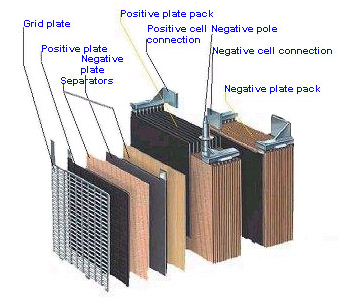Our Project
 For our electric car, we are using Exide Technologies' Orbital Deep Cycle battery. Ten, 12 volt batteries are wired together to create a 120 volt battery. The capacity is 50 amp/hours, so the total (theoretical) power is 6,000 watt-hours. Each battery weights 41 pounds, so the total weight is only 410 pounds! As our vehicle is light weight (but very strong because of our tubular steel construction), these batteries should provide a range of up to 50 miles per charge. (Actual performance testing began in July 2005). The vehicle has ample room for additional batteries should additional range be required.
For our electric car, we are using Exide Technologies' Orbital Deep Cycle battery. Ten, 12 volt batteries are wired together to create a 120 volt battery. The capacity is 50 amp/hours, so the total (theoretical) power is 6,000 watt-hours. Each battery weights 41 pounds, so the total weight is only 410 pounds! As our vehicle is light weight (but very strong because of our tubular steel construction), these batteries should provide a range of up to 50 miles per charge. (Actual performance testing began in July 2005). The vehicle has ample room for additional batteries should additional range be required.
Not only is this a top of the line, maintenance free battery that can be mounted anywhere, in any position; but we believe that this battery will provide the best overall performance. We've included some additional information about the Orbital Deep Cycle battery.

Battery Basics
While many people credit Alessandro Volta with the creation of the modern battery; there is substantial evidence to suggest that batteries were actually created more than 2000 years ago! The Baghdad Battery was discovered in the ruins of a village in 1936. It also appears that similar batteries have been located around ancient Egypt. Also, objects with traces of precious metal electroplating have been discovered at different locations.
The term Deep Cycle has been overused by the battery industry, as well as EV enthusiasts, to imply a heavy duty product. This has led to confusion and difficulty in battery selection. Any lead-acid battery may be termed "deep cycle" as all batteries may be fully discharged and charged. However, a true Deep Cycle battery is capable of thousands of these hard cycles during its life without losing its capacity. Many advertised deep cycle batteries composed of thin plates, excessively porous separators. Low density plate oxides will suffer permanent capacity loss after a few dozen cycles and will shortly sulfate or shed plate material and fail. Batteries without substantial materials designed for true deep cycling will lose more than half of their capacity after only a few cycles. What initially may seem to be an inexpensive battery to purchase now costs twice as much per Amp-hour.
True Deep Cycle batteries will perform well as cranking batteries; however, cranking batteries will not survive deep cycle use. {Car batteries are often called starting, lighting, and ignition (SLI) batteries.} Our main reason for using 12 volt batteries is our attempt to avoid creating a "lead sled". With a battery pack composed of 20, six volt batteries; the weight would be over 1300 pounds.
A battery is composed of "cells". The cell has one plate made of lead and another plate made of lead dioxide. The plates are immersed in strong sulfuric acid electrolyte. Lead combines with SO4 to create PbSO4, plus one electron. Lead dioxide, hydrogen ions and SO4 ions, plus electrons from the lead plate, create PbSO4 and water on the lead dioxide plate. As the battery discharges, both plates build up PbSO4 (lead sulfate), and water builds up in the acid. This allows you to use a hydrometer to measure the specific gravity of the battery to determine the battery's state of charge. The characteristic voltage is about 2 volts per cell, so by combining six cells you get a 12-volt battery.


 For our electric car, we are using Exide Technologies' Orbital Deep Cycle battery. Ten, 12 volt batteries are wired together to create a 120 volt battery. The capacity is 50 amp/hours, so the total (theoretical) power is 6,000 watt-hours. Each battery weights 41 pounds, so the total weight is only 410 pounds! As our vehicle is light weight (but very strong because of our tubular steel construction), these batteries should provide a range of up to 50 miles per charge. (Actual performance testing began in July 2005). The vehicle has ample room for additional batteries should additional range be required.
For our electric car, we are using Exide Technologies' Orbital Deep Cycle battery. Ten, 12 volt batteries are wired together to create a 120 volt battery. The capacity is 50 amp/hours, so the total (theoretical) power is 6,000 watt-hours. Each battery weights 41 pounds, so the total weight is only 410 pounds! As our vehicle is light weight (but very strong because of our tubular steel construction), these batteries should provide a range of up to 50 miles per charge. (Actual performance testing began in July 2005). The vehicle has ample room for additional batteries should additional range be required.

